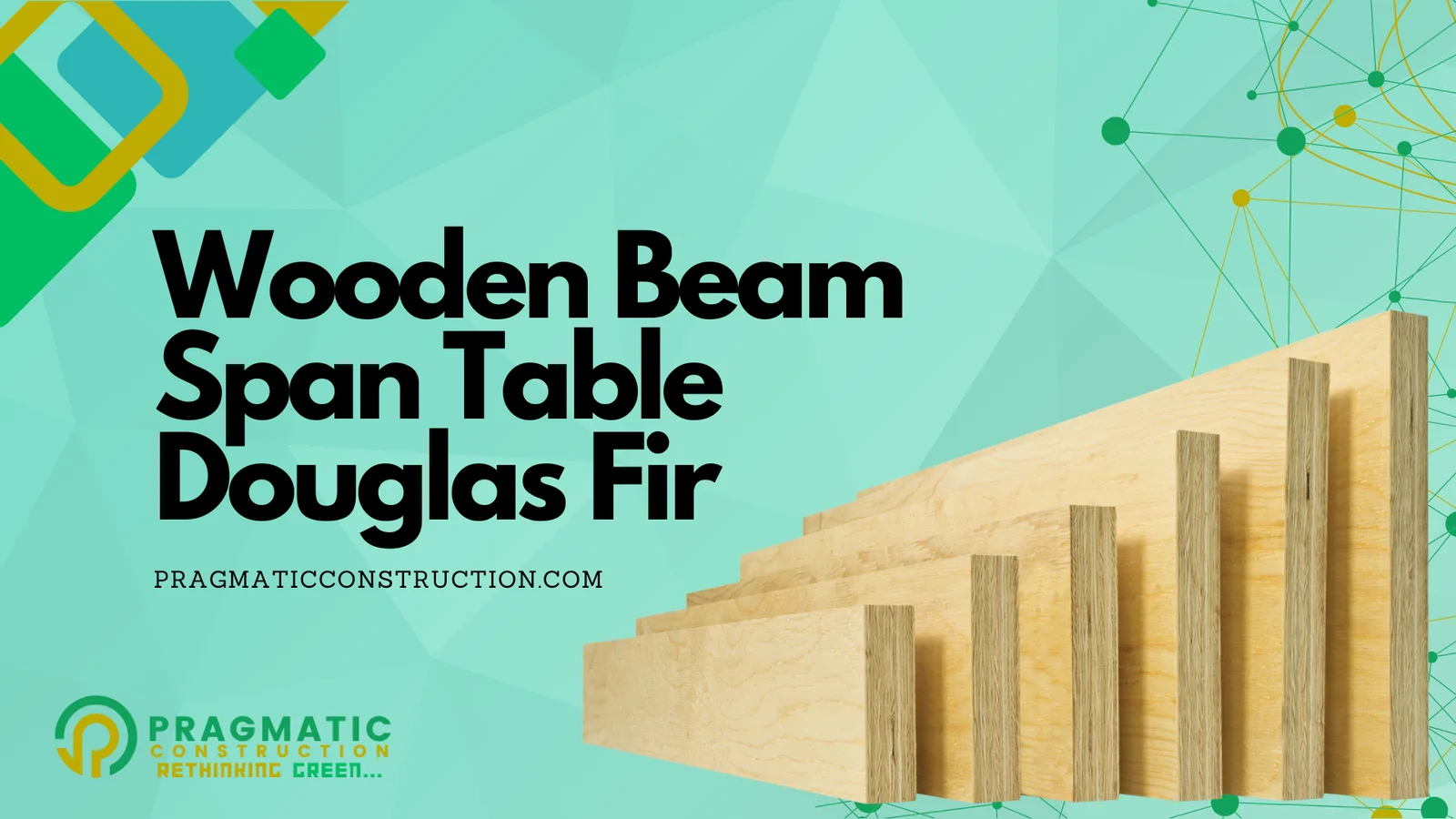Determining the appropriate span for wood beams, such as those made of Douglas Fir, is crucial in ensuring the structural integrity and safety of a construction project.
Span tables provide guidelines for the maximum recommended distances between supports for different sizes and types of wood beams, taking into account factors such as the wood species, load, and intended use.
Below is a simplified example of a wood beam span table for Douglas Fir.
Please note that this is a generic example, and actual span tables may vary based on local building codes and specific product specifications.

Wood Beam Span Table for Douglas Fir (Example)
The following table provides an example of span recommendations for Douglas Fir wood beams. It is important to consult with the appropriate building codes or a structural engineer for precise information tailored to your specific project and location.
| Beam Size (Nominal) | Species: Douglas Fir | Live Load (psf) | Dead Load (psf) | Maximum Span (feet) |
|---|---|---|---|---|
| 4×6 | Select Structural | 40 | 10 | 6′ – 8′ |
| 4×8 | No. 1 | 40 | 10 | 7′ – 10′ |
| 4×10 | No. 2 | 40 | 10 | 9′ – 0″ |
| 6×6 | Select Structural | 50 | 15 | 8′ – 6″ |
| 6×8 | No. 1 | 50 | 15 | 11′ – 0″ |
| 6×10 | No. 2 | 50 | 15 | 13′ – 4″ |
Note: The live load represents the temporary load a structure must support, such as people or furniture. The dead load refers to the permanent load, including the weight of the structure itself.
Considerations and Recommendations:
- Species and Grade: The species (Douglas Fir) and grade of the wood are critical factors in determining the allowable span. Higher-grade wood may have a longer allowable span.
- Load Conditions: Live and dead loads must be considered when selecting the appropriate beam size and span. Different applications, such as floors, roofs, or decks, may have different load requirements.
- Local Building Codes: Always refer to local building codes and regulations to ensure compliance with specific requirements in your area.
- Professional Consultation: For complex projects or those requiring precise calculations, it is advisable to consult with a structural engineer or other qualified professionals.
- Moisture Content: The moisture content of the wood can affect its strength. Be sure to consider the moisture conditions in your specific application.
This example provides a basic understanding of how a wood beam span table for Douglas Fir might be structured. However, it is imperative to consult with local authorities or a structural engineer to obtain accurate and site-specific information for your construction project.
How far can a wooden beam span?
The span of a wood beam is determined by its modulus of elasticity, size, and the load it is expected to carry.
For example, a 4″×10″ No. 1 Yellow Cedar beam with a modulus of elasticity of 1,400 kilopounds per square inch can typically span about 17.0 feet when supporting a uniform linear load of 80 pounds per foot.
However, adding just an additional 5 pounds per foot could lead to the beam’s failure. Conversely, shortening the beam to 16.5 feet would allow it to support 85 pounds per foot without failure.
Similarly, a 2″×10″ wooden beam can span approximately 5 to 7 feet of unbraced length when subjected to a combined loading of about 10 pounds per inch across the beam.
Softwood beams like Northern White Cedar typically span around 4.8 feet, while stiffer woods like Douglas Fir Larch can span up to 7.3 feet.
Regarding oak wood, its modulus of elasticity ranges from 800,000 to 1,400,000 pounds per square inch (psi). Lumber from white and mixed oaks may have a modulus of elasticity between 800,000 and 1,100,000 psi, while red oak lumber can range from 1,000,000 to 1,400,000 psi in stiffness.
How to find span of wooden beam?
To calculate the span of a wood beam, such as a 2″×8″ beam with actual measurements of 1.5″×7.5″, you’ll need to follow these steps:
- Determine the modulus of elasticity (E) of your wood beam.
- Find the area moment of inertia (I) using the formula: I = b × d³ / 12.
- If your beam needs to support a specific load per inch, use the equation: span = ∛[(8 × E × I)/(25 × w)], where w represents the load per inch.
For example, if your 2″×8″ beam has a modulus of elasticity of 1,900,000 psi and needs to support a load of 15 pounds per inch, the calculated span would be approximately 10.73 feet.
Actual and Allowable Deflection in wooden beam
The actual and allowable deflection of a wooden beam is a critical consideration in structural engineering to ensure the beam can safely support the intended loads without excessive bending or deformation.
Actual deflection refers to the amount of bending or displacement that occurs in a wooden beam when subjected to applied loads. This deflection is influenced by factors such as the beam’s material properties, dimensions, loading conditions, and support configuration.
Allowable deflection, on the other hand, refers to the maximum acceptable amount of deflection permitted for a wooden beam under design loads. It is determined based on industry standards, building codes, and engineering principles to ensure structural safety and serviceability.
The allowable deflection is typically specified as a fraction of the beam’s span length, such as L/240 or L/360, where L represents the span length of the beam.
For example, a common allowable deflection criterion is L/240, meaning the maximum deflection should not exceed 1/240th of the beam’s span length.
Engineers calculate the allowable deflection based on factors such as the beam’s material properties (e.g., modulus of elasticity), loading conditions (e.g., uniformly distributed loads, concentrated loads), and the intended use of the structure.
The goal is to limit deflection to ensure that the structure remains stable, avoids excessive deformation, and meets performance requirements for its intended application.
During the design process, engineers analyze the anticipated loads and deflection criteria to select appropriate beam sizes, configurations, and support arrangements to meet structural requirements while adhering to allowable deflection limits.
Regular inspections and monitoring of deflection during the construction and lifespan of a structure are essential to ensure ongoing structural integrity and safety.
Any deviations from allowable deflection limits may require remedial actions or structural reinforcement to address potential safety concerns.
Calculating Moment of Inertia & Deflection (With Examples)
The moment of inertia (I) for a wooden beam is a measure of its resistance to bending or flexural deformation. It depends on the beam’s cross-sectional geometry and material properties and is a crucial parameter in calculating beam deflection.
The formula for calculating the moment of inertia (I) of a wooden beam varies depending on its cross-sectional shape. For common shapes like rectangular, circular, or I-beam, the formulas are as follows:
- Rectangular Beam: I = (b * h^3) / 12 Where:
- b is the width of the beam (in inches or meters).
- h is the height or depth of the beam (in inches or meters).
- Circular Beam (for solid circular cross-section): I = π * (D^4 – d^4) / 64 Where:
- D is the outer diameter of the circular beam (in inches or meters).
- d is the inner diameter of the circular beam (in inches or meters).
- I-Beam (for standard I-section): I = (b * h^3 – (b – t) * (h – 2 * t)^3) / 12 Where:
- b is the total width of the beam (in inches or meters).
- h is the total height of the beam (in inches or meters).
- t is the thickness of the flanges (in inches or meters).
Once the moment of inertia (I) is determined, the formula for calculating the deflection (δ) of a wooden beam under a specific load (P) and span (L) is as follows:
δ = (P * L^3) / (3 * E * I) Where:
- P is the applied load (in pounds or newtons).
- L is the span length of the beam (in inches or meters).
- E is the modulus of elasticity of the beam material (in psi or Pa).
- I is the moment of inertia of the beam’s cross-section (in inches^4 or meters^4).
Example: Let’s consider a rectangular wooden beam with dimensions 4 inches wide and 6 inches deep. The beam is subjected to a uniformly distributed load of 1000 pounds over a span of 10 feet. The modulus of elasticity of the wood is 1,500,000 psi.
- Calculate the moment of inertia (I) using the formula for a rectangular beam: I = (4 * 6^3) / 12 = 288 inches^4
- Plug the values into the deflection formula: δ = (1000 * 120^3) / (3 * 1,500,000 * 288) ≈ 0.296 inches
Therefore, the deflection of the wooden beam under the given load and span would be approximately 0.296 inches.
Calculating Allowable Shear Stresses & Bending Stresses
Determining the allowable bending stresses and shear stresses in a wooden beam involves considering various factors such as the type of wood, beam geometry, loading conditions, and safety factors. Here’s how you can determine them:
Identify the Wood Species: Different wood species have different mechanical properties. Consult engineering literature or wood design codes to determine the allowable stresses for the specific wood species you are using.
Refer to Design Codes or Standards: Engineering design codes such as the National Design Specification (NDS) for Wood Construction provide guidelines for determining allowable stresses in wooden beams based on various factors including wood species, beam size, loading conditions, and duration of load.
Calculate Allowable Bending Stress: The allowable bending stress, also known as the bending or flexural strength, is the maximum stress a wooden beam can withstand without experiencing failure due to bending. It is typically calculated using the formula:Allowable Bending Stress (Fb) = Fb * Cd * Cm * Ct * Cf * CiWhere:
Fb is the base bending stress determined from design codes.
Cd is the duration of load factor.
Cm is the wet service factor (applicable for wet or outdoor conditions).
Ct is the temperature factor.
Cf is the size factor.
Ci is the incising factor (if applicable).
Calculate Allowable Shear Stress: The allowable shear stress is the maximum stress a wooden beam can withstand without experiencing failure due to shear. It is typically calculated using the formula:Allowable Shear Stress (Fv) = Fv * Cv * Ct * Cr * Cs * CfuWhere:
Fv is the base shear stress determined from design codes.
Cv is the duration of load factor.
Ct is the temperature factor.
Cr is the repetitive member factor.
Cs is the size factor.
Cfu is the flat use factor.
Apply Safety Factors: Design codes often specify safety factors to account for uncertainties in material properties, loading conditions, and other factors. Multiply the calculated allowable stresses by the appropriate safety factors to ensure structural safety.
Verify Compliance: After calculating the allowable stresses, compare them with the applied loads and stresses induced by the beam’s geometry and loading conditions. Ensure that the calculated stresses do not exceed the allowable stresses to prevent structural failure.
Example for calculating allowable bending & Shear Stresses in Wooden Beam
Certainly! Let’s use Douglas Fir, another commonly used wood species in construction, for the example:
Example:
Wood Species: Douglas Fir-Larch (DF-L)
Beam Size: 2×12 inches
Loading Conditions: The beam will be used as a header in a residential window opening, supporting a concentrated load of 10,000 pounds.
Step 1: Identify Wood Species: Douglas Fir-Larch is known for its high strength-to-weight ratio and is often used in structural applications.
Step 2: Refer to Design Codes: Using the National Design Specification (NDS) for Wood Construction, we find the following allowable stresses for DF-L:
- Allowable Bending Stress (Fb): 1,400 psi
- Allowable Shear Stress (Fv): 150 psi
Step 3: Calculate Allowable Bending Stress: Assuming typical loading conditions for headers, let’s assume:
- Cd (Duration of Load Factor): 1.15
- Cm (Wet Service Factor): 1.0 (assuming dry indoor conditions)
- Ct (Temperature Factor): 1.0 (assuming normal temperature)
- Cf (Size Factor): 1.0 (no adjustments for beam size)
- Ci (Incising Factor): 1.0 (assuming no incising)Allowable Bending Stress (Fb) = 1,400 psi * 1.15 * 1.0 * 1.0 * 1.0 * 1.0 = 1,610 psi
Step 4: Calculate Allowable Shear Stress: Using similar assumptions:
- Cv (Duration of Load Factor): 1.15
- Ct (Temperature Factor): 1.0
- Cr (Repetitive Member Factor): 1.0
- Cs (Size Factor): 1.0
- Cfu (Flat Use Factor): 1.0Allowable Shear Stress (Fv) = 150 psi * 1.15 * 1.0 * 1.0 * 1.0 * 1.0 = 172.5 psi
Step 5: Apply Safety Factors: For this example, let’s assume a safety factor of 1.5 for both bending and shear stresses.
Allowable Bending Stress with Safety Factor = 1,610 psi * 1.5 = 2,415 psi Allowable Shear Stress with Safety Factor = 172.5 psi * 1.5 = 258.75 psi
Step 6: Verify Compliance: Check that the calculated allowable stresses are greater than or equal to the stresses induced by the applied loads and beam geometry. If they are, the beam design is deemed safe for the given loading conditions.
This example demonstrates the process of determining allowable bending and shear stresses for a wooden beam using Douglas Fir-Larch, ensuring structural safety in construction applications.
The bottom Line
In conclusion, determining the allowable bending and shear stresses in a wooden beam, such as Douglas Fir-Larch, is crucial for ensuring structural integrity and safety in construction projects.
By referencing design codes, calculating the allowable stresses based on various factors, and applying appropriate safety factors, engineers and designers can confidently select and design wooden beams that meet the required load capacities and comply with industry standards.
It’s essential to consider the specific wood species, beam size, loading conditions, and environmental factors to accurately determine the allowable stresses.
By following these steps and verifying compliance, construction professionals can build with confidence, knowing that their wooden beams are adequately designed to withstand the anticipated loads and conditions, contributing to the overall safety and durability of the structure.

















